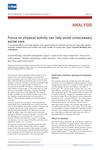Sign up to receive the latest news, research, policy updates and events about ageing.
SubscribeContact our team for more information
Contact usMost social and political commentators focus on cuts in public funding of social care, shortages of staff, the increasingly fragile financial state of care home providers, and knock-on consequences for the NHS.
The blame is usually placed on the rising numbers of older people, as if the requirement for social care was an unavoidable consequence of ageing. Thankfully, the need for social care is not inevitable. The UK National Institute for Health and Care Excellence (NICE) made it clear in 2015 that “disability, dementia and frailty can be prevented or delayed.” This remarkable statement received little publicity at the time.
A person’s need for care and support, whether provided by unpaid family carers or professional carers paid for personally or by the local authority, arises when someone is no longer able to manage vital activities of daily living such as washing, dressing, and feeding themselves. For illustration, for some people, the ability to get to the toilet in time is a threshold marking the difference between having carers visit twice a day and requiring live-in or residential care. The cost of care increases fivefold as this threshold is crossed. A residential care placement costs an average of £3,600 a year and may be required for months, years, or decades.
Ensuring that as many people as possible maintain the ability to manage vital activities of daily living requires a cultural change so that it becomes normal to expect people of all ages to be active. Concerted action by national and local organisations is also required to provide infrastructure and options, especially for those with fewest opportunities, who need most help.

Sign up to receive the latest news, research, policy updates and events about ageing.
SubscribeContact our team for more information
Contact us